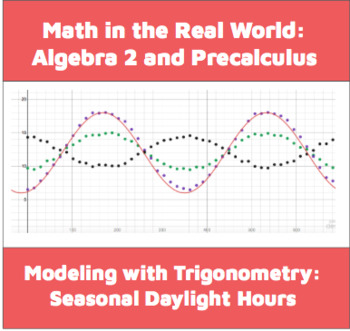Modeling Seasonal Daylight Length with Trig Functions
- Google Docs™

Products in this Bundle (2)
Description
In this activity, students analyze data sets modeling hours of sunlight in three cities over the course of the year (Sydney, Juneau, and Washington D.C.) To complete the activity, students must:
-- practice computing the parameters of sinusoidal functions and check their work by fitting an equation to the scatterplot
-- use their equations to predict the hours of sunlight on specific days of the year
-- use their graphs and equations to predict when pairs of cities will have the same amount of sunlight
-- interpret the meaning of different parameters by figuring out how their equations would be impacted by physical changes (e.g. the Earth's orbit around the sun speeds up.)
The optional extension questions in this activity ask students to imagine a planet in a "figure 8" orbit around a binary star system and to try to create a periodic function that models the hours of daylight on this planet. This is a problem on which students of all levels can make substantial progress, and it can be approached in many ways (right triangle trig, general triangle trig including Law of Sines and Law of Cosines, vectors, or multivariable calculus.) The precisely correct solution is challenging to derive.


